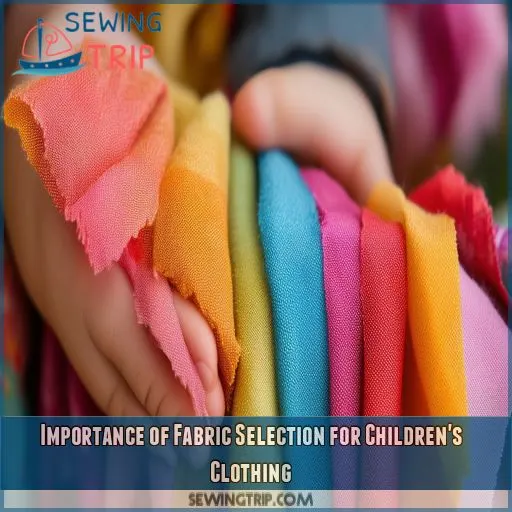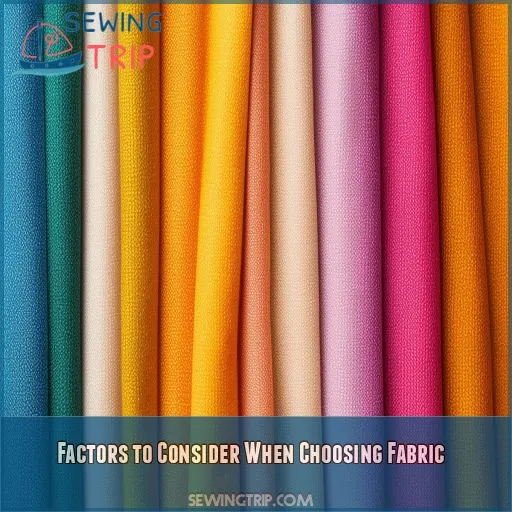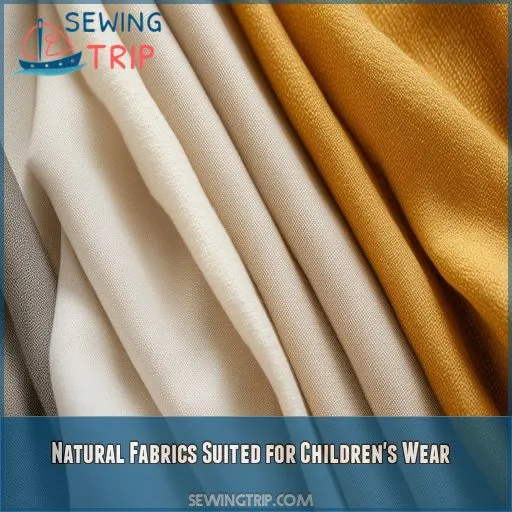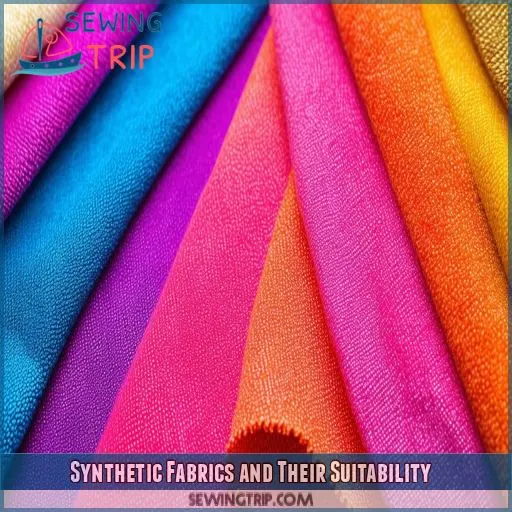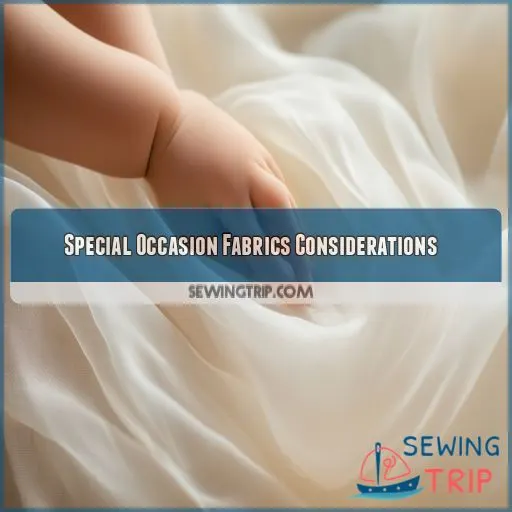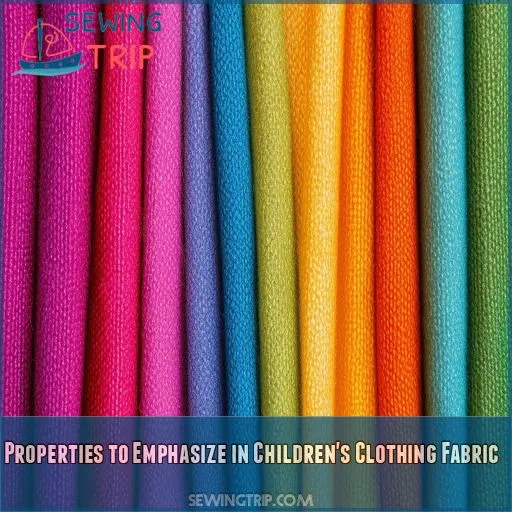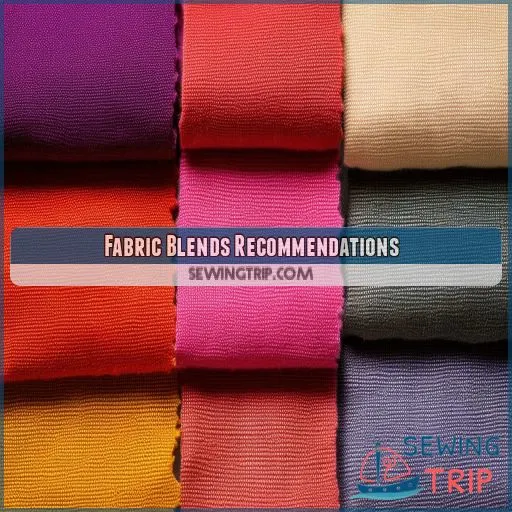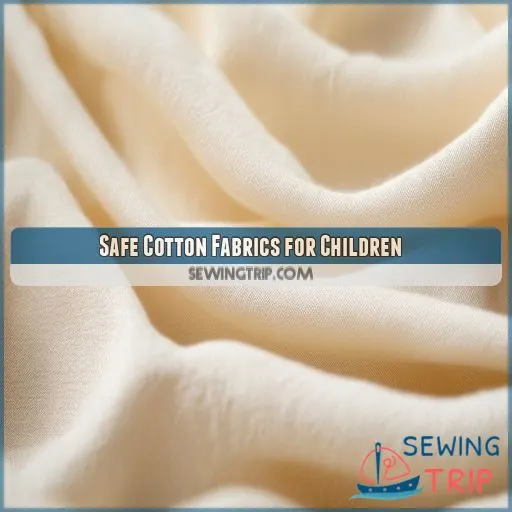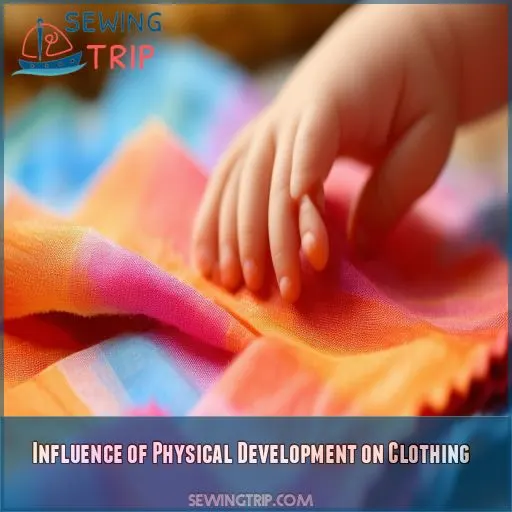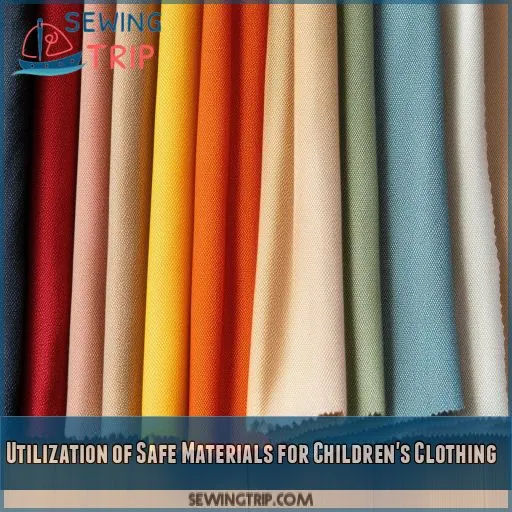This site is supported by our readers. We may earn a commission, at no cost to you, if you purchase through links.
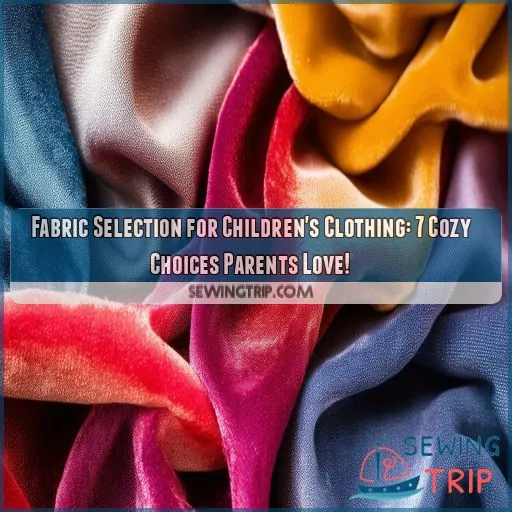
You’ll want to think about things like durability, ease of cleaning, and environmental impact.
This guide explores seven cozy fabric choices parents love for their kids’ wardrobes.
From breathable cotton to soft bamboo, we’ll examine natural and synthetic options suited for everyday wear and special occasions.
You’ll learn about key properties to look for and how fabric selection can impact your child’s physical development and well-being.
Table Of Contents
- Key Takeaways
- Importance of Fabric Selection for Children’s Clothing
- Factors to Consider When Choosing Fabric
- Natural Fabrics Suited for Children’s Wear
- Synthetic Fabrics and Their Suitability
- Special Occasion Fabrics Considerations
- Properties to Emphasize in Children’s Clothing Fabric
- Fabric Blends Recommendations
- Safe Cotton Fabrics for Children
- Influence of Physical Development on Clothing
- Utilization of Safe Materials for Children’s Clothing
- Frequently Asked Questions (FAQs)
- Conclusion
Key Takeaways
- Comfort is king! Choose breathable, soft fabrics like cotton and bamboo that’ll keep your little ones feeling cozy while they conquer the playground. After all, a comfy kid is a happy kid!
- Safety first, fashion second. Opt for hypoallergenic materials and flame-resistant options, especially for sleepwear. You want your child wrapped in a protective cocoon, not a potential hazard.
- Durability is your new best friend. Kids are tiny tornados of energy, so pick fabrics that can weather the storm of constant play, spills, and washing. Your wallet (and sanity) will thank you later!
- Don’t forget Mother Nature! Eco-friendly fabric choices like organic cotton and bamboo are a win-win: gentle on your child’s skin and kind to the planet. It’s like dressing your kids in a hug from Mother Earth herself!
Importance of Fabric Selection for Children’s Clothing
When selecting fabrics for children’s clothing, you’ll want to prioritize safety, comfort, and durability so your little ones can play freely without worry. You should also consider the environmental impact of different fabric choices, as sustainable options can benefit both your child and the planet.
Safety And Comfort
Your little one’s wardrobe is all about safety and comfort. You want fabrics that are gentle on their sensitive skin and won’t cause allergies. Organic cotton and merino wool are great choices, and Oeko-Tex certification means they’re safe. Here’s what to look for:
- Soft, breathable cotton fabrics
- Smooth textures that won’t irritate
- Natural fibers free from harsh chemicals
Durability For Play
Kids’ clothes need to hold up, especially when they’re always on the go. Here are some fabrics that can handle the wear and tear of playtime:
| Fabric | Durability | Best For |
|---|---|---|
| Cotton | High | Everyday wear |
| Knit Jersey | Medium | Comfortable play clothes |
| Interlock | High | Active outdoor play |
| Loopback Jersey | Very High | Rough-and-tumble activities |
These fabrics offer a perfect blend of comfort and toughness, ensuring your active kids stay cozy without compromising on style.
Environmental Considerations
When choosing fabrics for your little ones, don’t forget Mother Earth! Durability isn’t the only consideration; we need to think green too. Choosing eco-friendly materials means you’re dressing your kids responsibly. Here are some sustainable options to keep in mind:
- Organic cotton: Pesticide-free and gentle on skin
- Bamboo: Fast-growing and biodegradable
- Linen: Made from flax, requires minimal water to grow
These choices not only protect your child but also safeguard our planet’s future.
Factors to Consider When Choosing Fabric
When selecting fabrics for your child’s clothing, you need to think about a few key things to make sure they’re comfy, durable, and safe. This means looking at how comfortable the fabric is, how well it holds up to wear and tear, how easy it’s to clean, whether it’s safe for sensitive skin, and how it affects the environment.
Comfort
When selecting fabrics for your little one’s wardrobe, comfort is king.
You’ll want to prioritize softness and breathability to keep sensitive skin happy.
Natural fibers like single jersey cotton and fleece are top picks for clothing comfort.
Knitted fabrics offer excellent temperature regulation, ensuring your child stays cozy without overheating.
Durability
For your little one’s play clothes, durability is key.
You’ll want fabrics that can withstand the wear and tear of active play.
Wool and poplin are sturdy choices that’ll last through countless adventures.
Look for reinforced knees and elbows in trousers and shirts.
Ease of Cleaning
For kids’ clothes, durability and easy cleaning go hand-in-hand.
You’ll want fabrics that can handle frequent machine washing and stain removal.
Look for quick-drying materials that can handle a gentle cycle.
Easy-care options are a godsend for busy parents.
Whether it’s baby clothes, toddler outfits, or children’s wear, opt for fabrics that don’t require special treatment.
Your washing machine will thank you!
Safety
When choosing fabrics for your little ones, safety’s paramount.
You’ll want to steer clear of materials that might trigger allergies or irritate sensitive skin.
Opt for natural fabrics like organic cotton or bamboo, which are less likely to contain harmful chemicals.
Synthetic fabrics can be safe too, but double-check for potential irritants.
For extra peace of mind, consider fireproof clothing options, especially for sleepwear.
Environmental Impact
When choosing fabrics for your little ones, you’re not just protecting their skin; you’re safeguarding our planet too.
Sustainable textile choices are a game-changer in children’s clothing.
Opt for eco-friendly fabrics like organic cotton or bamboo, which are produced with minimal environmental impact.
These ethical production methods mean you’re dressing your kids in comfort while supporting sustainable fashion.
It’s a win-win for both your family and Mother Earth!
Natural Fabrics Suited for Children’s Wear
When selecting fabrics for your child’s clothing, natural fibers like cotton, linen, wool, and bamboo are excellent choices that offer comfort and durability. These materials provide breathability, moisture-wicking properties, and hypoallergenic benefits, making them ideal for children’s sensitive skin and active lifestyles.
Cotton
For kids’ clothes, cotton is the go-to choice for comfort and safety. You’ll love its breathability and moisture-wicking properties, perfect for keeping your little ones cool and dry. Organic cotton takes it up a notch, ensuring your kids are wrapped in pesticide-free goodness.
Here’s why cotton is a parent’s best friend:
- Hypoallergenic, ideal for sensitive skin
- Durable enough to withstand playground adventures
- Easy to clean and maintain
- Versatile for various activities and seasons
Linen
You’ll love linen for your kids’ clothing!
It’s incredibly breathable and moisture-wicking, perfect for keeping your little ones cool during hot summer days.
While pure linen can be a bit rough, opt for thin linen or linen blends for softer comfort.
It’s durable too, withstanding the wear and tear of active play.
Just remember, linen wrinkles easily, so be prepared for some extra care when doing laundry.
Wool
While linen keeps your little ones cool, wool wraps them in warmth when the temperature drops. You’ll love wool’s natural properties for children’s clothing:
- Cozy insulation without bulk
- Moisture-wicking abilities to keep kids dry
- Durability for active play
Don’t worry about the itchy reputation – modern wool blends are soft and comfortable. From snuggly sweaters to dress-up clothes, wool’s versatility makes it a smart fabric selection for children’s clothing and bedding.
Bamboo
Moving from wool’s warmth, let’s explore bamboo fabric, a rising star in children’s wear. You’ll love its silky-soft feel and eco-friendly nature. Bamboo clothing offers unique benefits, outshining cotton in many ways. Here’s a quick comparison:
| Feature | Bamboo | Cotton |
|---|---|---|
| Softness | Ultra-soft | Soft |
| Breathability | Excellent | Good |
| Moisture-wicking | Superior | Moderate |
Growing bamboo is sustainable, making it a top choice for eco-conscious parents. From cozy pajamas to bias binding on broderie anglaise dresses, bamboo’s versatility shines in children’s clothing and bedding.
Synthetic Fabrics and Their Suitability
While natural fabrics are fantastic, synthetic options can be just as cozy for your little ones. Let’s take a closer look at man-made materials and see why they’re becoming more popular in children’s clothing.
Fleece is a top choice among synthetic fabrics. This fuzzy wonder offers:
- Unbeatable warmth without the bulk
- Quick-drying properties for active kids
- Durability that withstands countless washes
You’ll love how fleece performs in various situations, from playground adventures to chilly winter days. Its versatility means it’s perfect for jackets, pants, and even blankets. Plus, it’s a breeze to care for – just toss it in the wash and you’re good to go!
With advances in textile technology, synthetic fabrics are constantly improving. They’re designed to mimic the best properties of natural materials while offering enhanced performance. Your child can stay comfortable and stylish in these modern marvels.
Special Occasion Fabrics Considerations
When selecting fabrics for children’s special occasion wear, you’ll need to balance luxurious choices with comfort and durability. Consider options like silk blends or high-quality cottons that offer both style and practicality, ensuring your child looks great while staying comfortable throughout the event.
Luxurious Fabric Choices
While synthetic fabrics have their place, special occasions call for something extra luxurious. You’ll want to explore fabrics that feel as good as they look. Here’s a quick rundown of some opulent choices:
| Fabric | Appearance | Texture | Ideal For | Care Level |
|---|---|---|---|---|
| Silk | Lustrous | Smooth | Dresses, Blouses | High |
| Satin | Shiny | Sleek | Gowns, Ties | Moderate |
| Velvet | Plush | Soft | Jackets, Skirts | High |
| Cashmere | Matte | Fluffy | Sweaters, Scarves | High |
| Organza | Sheer | Crisp | Overlays, Bows | Moderate |
Comfort Vs. Style
When choosing special occasion fabrics for your little ones, you’ll often find yourself weighing comfort against style. While you want your child to look adorable, their comfort should never be compromised. Remember, a comfortable child is a happy child. Here are three key considerations:
- Breathability: Opt for fabrics that allow air circulation
- Softness: Choose materials that won’t irritate sensitive skin
- Flexibility: Select fabrics that allow for easy movement
Making sure your child looks great and feels even better is easy when you balance style with these comfort factors.
Durability For Events
When choosing fabrics for special events, you’ll want to strike a balance between style and durability.
Consider options like satin or polyester blends that can withstand the excitement of the occasion while still looking sharp.
These fabric choices offer resistance to wrinkles and stains, ensuring your little one stays picture-perfect throughout the event.
Properties to Emphasize in Children’s Clothing Fabric
When selecting fabrics for children’s clothing, you’ll want to prioritize properties that enhance comfort and safety. Key features to look for include breathability to regulate temperature, moisture-wicking capabilities to keep skin dry, hypoallergenic qualities for sensitive skin, and appropriate warmth for different seasons.
Breathability
When selecting fabrics for your little ones, breathability is key. You’ll want to choose materials that allow air to circulate, keeping your child comfortable and cool. Breathable fabrics help regulate body temperature and prevent overheating, especially during active play or warm weather.
- Cotton: Nature’s go-to for breathability
- Linen: The ultimate summer fabric for kids
- Wool: Surprisingly breathable, even in cooler temperatures
These fabrics will keep your child feeling fresh and cozy, no matter the season or activity.
Moisture-wicking
Keeping your little ones comfy is all about choosing the right fabrics.
Moisture-wicking materials are a game-changer for summer playtime. These sweat-absorbing fabrics work overtime to keep kids dry.
You’ll want to look for breathable clothing that pulls moisture away from the skin, helping to regulate body temperature.
Cotton, bamboo, and certain synthetic blends excel at this, ensuring your child stays cool and dry even during the most active adventures.
Hypoallergenic
While moisture-wicking fabrics keep your little ones dry, it’s equally important to choose hypoallergenic materials. These fabrics are gentle on sensitive skin, reducing the risk of allergies, eczema flare-ups, and uncomfortable reactions. You’ll want to prioritize fabrics that:
- Cradle your child’s delicate skin like a soft, protective cocoon
- Shield against irritants as if they’re wearing an invisible suit of armor
- Provide peace of mind, knowing you’re safeguarding your little one’s comfort
Cotton and bamboo are excellent hypoallergenic choices for your child’s wardrobe.
Warmth
For warmth, you’ll want fabrics that keep your little ones cozy without overheating. Layering is key, especially as seasons change. Let’s break down some top choices for warmth:
| Fabric | Warmth Level | Best For |
|---|---|---|
| Wool | High | Winter |
| Fleece | High | Outdoor |
| Cotton | Moderate | All Year |
| Flannel | High | Bedtime |
| Bamboo | Moderate | Layering |
These fabrics offer varying degrees of warmth, ensuring your child stays comfortable in any weather.
Fabric Blends Recommendations
You’ll find that fabric blends offer the best of both worlds, combining the strengths of different materials for great comfort and durability in children’s clothing. Consider cotton blends for breathability and softness, linen blends for a cooler feel, and wool blends for warmth without the itch, all of which provide better performance compared to their pure counterparts.
Cotton Blends
For comfort and durability, cotton blends are your go-to fabric for kids’ clothing. These stretch fabrics offer the best of both worlds:
- Breathability of pure cotton
- Added strength from synthetic fibers
- Improved shape retention
- Enhanced wrinkle resistance
You’ll love how cotton blends keep your little ones comfy while withstanding the rigors of playtime. They’re versatile enough for everyday wear and special occasions, making them a smart choice for your child’s wardrobe.
Linen Blends
You’ll love linen blends for your little ones!
These fabrics combine the best of both worlds – linen’s breathability with added softness and durability.
Say goodbye to wrinkle woes; these blends often come wrinkle-free.
They’re perfect for those hot summer days when you want your kids to stay cool and comfy.
Plus, they’re tough enough to withstand playground adventures.
Give linen blends a try – your kids will thank you!
Wool Blends
You’ll love wool blends for your kids’ clothing! These fabrics combine the warmth factor of wool with the softness levels of other materials, passing the durability test with flying colors. Say goodbye to scratchy fibers and hello to cozy comfort. Here’s why wool blends are a smart choice:
- Merino wool and cotton blends offer supreme softness
- Wool-acrylic mixes provide warmth without the itch
- Cashmere blends add a touch of luxury to everyday wear
- Wool-polyester combinations enhance durability for active kids
Safe Cotton Fabrics for Children
You’ll find several safe cotton fabrics ideal for children’s clothing, including cotton satin, voile, poplin, interlock, single jersey, and loopback jersey. These options offer a blend of comfort, durability, and safety, making them popular choices among parents who prioritize their children’s well-being and style.
Cotton Satin
For cozy choices for your little ones, cotton satin is a top contender. Building on our discussion of fabric blends, this luxurious material offers a perfect balance of softness and durability. You’ll love its smooth texture and versatility for both everyday wear and special occasions. Here’s a quick look at why cotton satin is a parent favorite:
| Characteristic | Benefit | Parent Approval |
|---|---|---|
| Softness | Gentle on skin | ️️️️️ |
| Durability | Withstands play | ️️️️ |
| Texture | Smooth and comfy | ️️️️️ |
| Versatility | Everyday to dressy | ️️️️ |
Voile
Voile, another lightweight cotton fabric, offers a delightful contrast to cotton satin.
You’ll love its sheer, airy texture that keeps your little ones cool in warm weather.
This versatile fabric boasts a soft drape and subtle sheen, making it perfect for summer dresses and blouses.
Its breathability and featherlight weight make your child feel comfortable, while its durability stands up to active play and frequent washing.
Cotton Poplin
You’ll love cotton poplin for your little one’s wardrobe.
This fabric takes the softness of cotton to the next level, offering a smooth, crisp texture that’s incredibly comfortable against your child’s skin.
It’s breathable, keeping your kiddo cool during playtime, and durable enough to withstand countless washes.
Plus, its versatility makes it perfect for everything from everyday wear to special occasions.
Cotton Interlock
You’ll love cotton interlock for your little one’s wardrobe.
This fabric blend boasts a soft texture that’s gentle on delicate skin.
With its stretch factor, it’s perfect for baby clothes that need to grow with your child.
Cotton interlock offers the best of both worlds – the comfort of natural fibers and the flexibility of a knit fabric.
It’s a win-win for parents and babies alike!
Single Jersey
You’ll love single jersey for your little ones!
This knit fabric is a parent’s dream, offering the perfect blend of comfort and functionality.
Its stretchy nature allows for easy movement, while its softness keeps your child cozy all day long.
The breathable fabric wicks away moisture, ensuring your kiddo stays dry during playtime.
It’s no wonder single jersey is a go-to choice for children’s clothing!
Loopback Jersey
Loopback jersey is a cozy fabric type you’ll love for your kids’ clothing. This cotton-based material offers a soft, comfortable feel with excellent breathability. Here are four benefits of loopback jersey:
- Moisture-wicking properties
- Durable and long-lasting
- Easy to care for and maintain
- Versatile for various garments
You’ll find this fabric perfect for sweatshirts, joggers, and casual wear. Its unique looped back provides extra warmth without sacrificing comfort, making it ideal for active children.
Influence of Physical Development on Clothing
As your child grows and develops, their clothing needs will change to accommodate their physical abilities and independence. You’ll want to choose fabrics and styles that allow for easy dressing and undressing, while also ensuring comfort and safety for your young one’s active lifestyle.
Clothes for Easy Dressing
When dressing your little ones, easy-on, easy-off clothes are a game-changer.
You’ll want to look for stretchy fabrics and simple fasteners that won’t frustrate tiny hands.
Think elastic waistbands, snap buttons, and wide necklines.
These features make dressing a breeze and help keep your child safe during playtime.
Comfortable Clothing Importance
As your kids grow, comfortable clothes become even more important. You’ll want to make sure their outfits don’t hinder movement or cause discomfort. Here’s why comfortable wear matters:
- Promotes physical activity and exploration
- Reduces irritability and fussiness
- Supports proper development of motor skills
- Encourages independence in dressing
Safe Clothing for Young Children
For young children’s clothing, safety is the top priority.
You’ll want to choose fabrics that are gentle on their delicate skin, steering clear of potential allergies, irritations, or reactions.
Opt for soft, breathable materials that won’t chafe or cause discomfort.
It’s all about comfort and safety first!
Utilization of Safe Materials for Children’s Clothing
As your child grows, their safety remains paramount. When selecting fabrics, opt for materials that are comfortable and chemical-free. Organic cotton is a top choice, offering softness and breathability without harmful pesticides. You’ll want to prioritize safe fabrics that protect your little one’s delicate skin while allowing them to move and play freely.
Consider these safe options for your child’s wardrobe:
- GOTS-certified organic cotton
- Bamboo-based fabrics
- Tencel or lyocell
- Hemp blends
These materials are gentle on the skin and eco-friendly. Remember, what touches your child’s skin matters. By choosing organic and chemical-free fabrics, you’re ensuring their comfort and well-being. It’s like wrapping them in a protective cocoon, allowing them to explore the world without worry. Your little adventurer deserves the best, so don’t skimp on fabric quality – it’s an investment in their health and happiness.
Frequently Asked Questions (FAQs)
What type of fabric is suited for children’s wear?
You’ll want breathable, durable fabrics for kids’ clothes. Cotton’s a top choice, offering comfort and versatility. Linen’s great for summer, while wool keeps them warm in winter. Don’t forget fleece for cozy outerwear. Mix and match for all seasons!
What are the points to consider in choosing fabric for children’s wear?
When choosing fabric for kids’ wear, you’ll want to think about comfort, durability, safety, and ease of care. Look for breathable, soft materials that can withstand play and washing. Don’t forget to factor in seasonality and potential allergies.
What are 4 guidelines for choosing children’s clothing?
Choose comfort first: opt for soft, breathable fabrics. Prioritize safety with flame-resistant materials. Consider durability for active kids. Don’t forget practicality: easy-to-wash fabrics save time. These guidelines will help your little ones stay comfy, safe, and stylish.
What is the most breathable fabric for kids?
Linen’s your go-to for breathability in kids’ clothes. It’s nature’s air conditioner, wicking moisture and keeping little ones cool. You’ll love how it regulates temperature, especially during those scorching summer days. It’s a game-changer for active kiddos!
How often should childrens clothing be replaced?
You’ll need to replace your kids’ clothes every 3-6 months, depending on their growth rate and wear and tear. Keep an eye on fit, fabric condition, and seasonal changes to make sure they’re comfortable and properly protected.
Are there fabrics that help reduce body odor?
Dial up your odor defense! You’ll want fabrics with antimicrobial properties like bamboo, wool, and silver-infused textiles. They’re your digital-age armor against stink, effectively wicking moisture and inhibiting bacteria growth. Cotton blends with these materials also work well.
Which fabrics are best for children with sensory issues?
For kids with sensory issues, you’ll want to choose soft, seamless fabrics. Cotton, bamboo, and modal are excellent options. They’re breathable, gentle on the skin, and won’t cause irritation. Avoid scratchy materials like wool or synthetic blends.
Can fabric choices affect a childs sleep quality?
You might be surprised to learn that fabric choices can really affect your child’s sleep quality. Breathable, moisture-wicking materials like cotton and bamboo can help regulate body temperature, while synthetic fabrics may cause discomfort and overheating, disrupting their precious slumber.
Are there fabrics that offer UV protection for children?
Yes, you’ll find fabrics with built-in UV protection for your little ones. Look for tightly woven materials like denim or specially treated fabrics. Some brands even offer UPF-rated clothing, shielding your child’s delicate skin from harmful sun rays.
Conclusion
Fabric selection for children’s clothing is no child’s play.
You’ve learned about the importance of comfort, safety, and durability in your little one’s wardrobe.
From natural fibers like cotton and bamboo to synthetic options, you’re now equipped to make informed choices.
Remember to keep in mind factors like breathability, ease of cleaning, and environmental impact.
By prioritizing the right fabrics, you’ll make sure your child’s clothing supports their physical development and well-being.
Make smart fabric choices, and your kids will thank you with happy, comfortable play.

